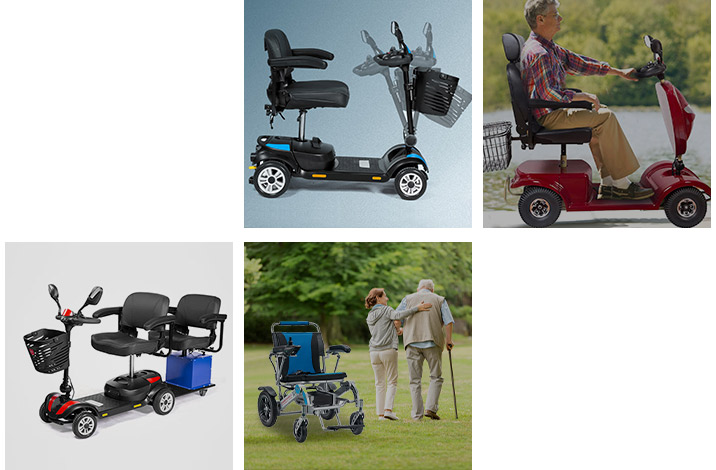Industry knowledge
The Importance of 3 Wheels Elderly Mobility Scooter
Three-wheel elderly mobility scooters play a significant role in providing mobility and independence to individuals with limited mobility, particularly older adults. Here are some reasons why three-wheel scooters are important:
Maneuverability: Three-wheel scooters are known for their excellent maneuverability, particularly in tight spaces. Their compact design and smaller turning radius allow users to navigate through narrow hallways, crowded areas, and other confined environments more easily compared to larger, four-wheel scooters. This makes them suitable for indoor use, such as in homes, stores, or other tight spaces.
Stability: Despite having one less wheel than four-wheel scooters, three-wheel scooters still offer a stable ride. The placement of the wheels and the scooter's center of gravity are designed to ensure balance and stability during operation. The stability of three-wheel scooters is enhanced by their wider rear wheelbase, which provides good stability on straightaways and while making turns.
Accessibility: Three-wheel scooters are often designed with accessibility in mind. They typically have a lower platform height, making it easier for individuals with mobility challenges to get on and off the scooter. The lower step-on height reduces the effort required to mount the scooter, making it more accessible for individuals with limited strength or flexibility.
Lightweight and Compact: Three-wheel scooters are generally lighter and more compact compared to their four-wheel counterparts. This makes them easier to transport and store, as they require less space and can be disassembled or folded for convenience. The lightweight nature of three-wheel scooters also makes them more manageable for users who may have difficulty lifting heavier objects.
Enhanced Outdoor Performance: While three-wheel scooters are typically used indoors, they can also perform well outdoors. The narrower front-end of the scooter allows for greater maneuverability on sidewalks, pathways, and other outdoor environments. They can handle uneven terrain and slight inclines with relative ease, providing users with the ability to enjoy outdoor activities and navigate through parks or shopping centers.
Improved Visibility: Three-wheel scooters often have a more open design, providing better visibility for the user. This can be particularly advantageous in crowded areas or when maneuvering through tight spaces, as it allows for better awareness of surrounding obstacles or pedestrians.
How to Install 3 Wheels Elderly Mobility Scooter
Installing a
3-wheeled elderly mobility scooter typically involves a few key steps. Although the exact installation process may vary depending on the specific model and manufacturer, here is a general guide to help you get started:
Unpack and inspect: Carefully unpack the mobility scooter and inspect all the components. Ensure that all parts are included and in good condition before proceeding with the installation.
Battery installation: Locate the battery compartment, which is usually located under the seat. Follow the manufacturer's instructions to properly install the battery. This may involve connecting cables or sliding the battery into a designated slot. Make sure the battery is securely in place.
Attach the seat: Position the seat onto the scooter's base and align the mounting holes. Use the provided bolts or fasteners to secure the seat to the scooter. Tighten the bolts securely, but be careful not to overtighten.
Attach the tiller: The tiller is the steering column of the mobility scooter. It is typically detachable for ease of transportation and storage. Align the tiller with the base and insert it into the designated socket. Use any locking mechanism or fasteners provided to secure the tiller in place.
Adjust the tiller: Most mobility scooters allow you to adjust the height and angle of the tiller to suit the user's preferences and comfort. Follow the manufacturer's instructions to make any necessary adjustments. Ensure that the tiller is securely locked in the desired position.
Verify the controls: Check that all the control buttons and switches on the tiller are properly functioning. This includes the power switch, speed controls, horn, and any other features specific to your model. Refer to the user manual for guidance on operating the controls.
Test the mobility scooter: Before using the scooter, it's important to test its functionality and ensure everything is in working order. Check that the battery is adequately charged, and turn on the power. Gradually increase the speed to verify that the scooter responds as expected and the brakes work effectively. Test the steering and maneuverability to ensure a smooth and controlled ride.
Familiarize yourself with safety features: Take the time to understand the safety features of the mobility scooter, such as the brakes, lights, and any additional safety mechanisms. Review the user manual to fully comprehend the scooter's safety guidelines and precautions.



 English
English Deutsch
Deutsch






















-3.jpg?imageView2/2/format/jp2)
.jpg?imageView2/2/format/jp2)






